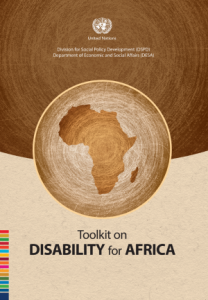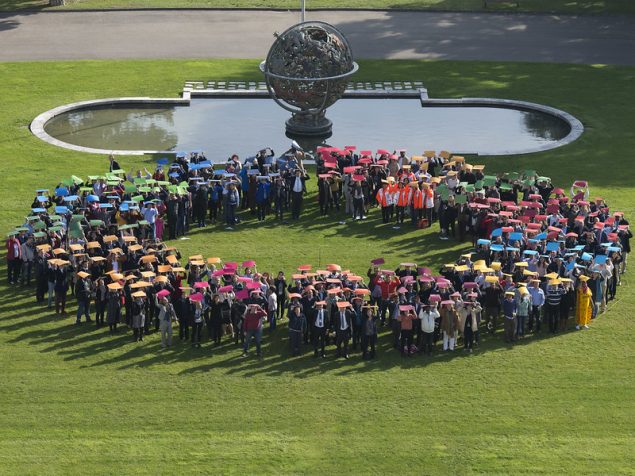Backgrounder: Disability Treaty Closes a Gap in Protecting Human Rights [WORD]
There are seven landmark United Nations human rights treaties that protect the rights of women, children, migrant workers and others, but until the Convention on the Rights of Persons with Disabilities entered into force on 3 May 2008, there has been no specific global treaty addressing the needs of persons with disabilities, the world’s largest minority.
While many contended that existing treaties covered persons with disabilities along with everybody else, it was clear that without a legally binding treaty that spelled out their rights, persons with disabilities faced being legally “invisible” in their societies and even in the international arena. The result has been that persons with disabilities continue to face major hurdles and discriminatory practices in their daily lives.
About 650 million people in the world – or about 10 per cent of the total world population – experience various forms of disabilities, according to the World Health Organization (WHO). Eighty per cent of persons with disabilities – more than 400 million people – live in poor countries, the least equipped to address their needs. All over the world, persons with disabilities continue to face barriers in their participation in society and lower standards of living.
When immediate family members are included, the number of people affected by disabilities exceeds one billion. This is particularly important, as disabilities are a contributing factor for poverty, reduced access to education and health, exclusion and discrimination for both persons with disabilities and their families.
The purpose of the Convention, as stated in Article 1, is to “to promote, protect and ensure the full and equal enjoyment of all human rights and fundamental freedoms by all persons with disabilities, and to promote respect for their inherent dignity.”
The Convention marks a major shift in the way societies view persons with disabilities, with the person being the key decision-maker in his or her own life. It makes persons with disabilities “rights holders” and “subjects of law”, with full participation in formulating and implementing plans and policies affecting them.
Disability is a socially created problem
The Convention moves beyond the question of access to the physical environment, to broader issues of equality and elimination of legal and social barriers to participation, social opportunities, health, education, employment and personal development.
States that ratify the Convention are legally bound to treat persons with disabilities not just as victims or members of a minority, but as subjects of the law with clearly defined rights. They will have to adapt their domestic legislation to the international standards set forth in the treaty.
The Convention promotes human rights standards and their application from a “disability perspective”, promoting equal citizenship after a long history of discrimination.
The treaty views disability as a result of the interaction between an inaccessible environment and a person, rather than an inherent attribute of an individual. It replaces the old “medical model” of disability by a social and human rights model based on the fact that it is society that “disables” persons with disabilities from exercising their human rights as citizens.
This approach reflects the social perspective taken by the International Classification of Functioning of WHO, which sees disability as a universal human experience and not a concern of a minority: every human being can suffer from a health loss and experience some disability.
The Convention sets global standards on disability rights
The global population of persons with disabilities is increasing, says WHO. Population growth, medical advances and the ageing of the world population all contribute to this increase. In countries with life expectancies over 70 years, individuals spend on average about 8 years, or 11.5 per cent of their life span, living with disabilities.
Many countries still do not have laws on disability. According to the Inter-Parliamentary Union, only one third of countries have anti-discrimination and other disability-specific laws. The Convention will prompt governments to create legislation or improve current laws to bring them up to the standards it sets.
The Convention has many other advantages. It provides accepted global legal standards on disability rights; clarifies the content of human rights principles and their application to the situation of persons with disabilities; provides an authoritative and global reference point for domestic laws and policies; provides effective mechanisms for monitoring, including supervision by a body of experts and reporting on implementation by governments and NGOs; provides a standard of assessment and achievement; and establishes a framework for international cooperation. It also helps to educate public opinion as countries consider ratification.
The treaty recognizes reproductive rights and is the first universal human rights treaty that mentions sexual and reproductive health. Studies show that persons with disabilities are up to three times more likely to be victims of physical and sexual abuse, and are at greater risk of contracting HIV/AIDS.
Organizations of persons with disabilities fully participated in the negotiations and had a significant impact on the drafting of the Convention. The treaty provides for the creation of national independent structures responsible for its implementation and monitoring. Persons with disabilities and representatives of disability organizations are to be members of such bodies.
Persons with disabilities are empowered
For countries ratifying the Optional Protocol to the Convention, a body of experts will be able to consider complaints from individuals or groups on inadequate implementation of the treaty, once all national recourse procedures have been exhausted.
The Convention gives persons with disabilities a powerful tool. “The mere existence of the Convention gives persons with disabilities and their organizations the ability to say to their governments, ‘You have accepted these obligations’, and insist that they be met;” said Don MacKay, the Chairman of the committee that drafted the treaty.
But to realize the rights enshrined in the Convention, a fundamental change of attitude is necessary. “Disability,” says the Convention, “results from the interaction between persons with impairments and attitudinal and environmental barriers that hinder their full and effective participation in society.” Changing attitudes towards persons with disabilities will be necessary to make the objectives of the Convention a reality.
“It is all a matter of breaking down negative perceptions,” said Chris Sullivan, a Merrill Lynch Vice-President who was born hearing-impaired. “You have to look at the person and not at the disability. That requires a tremendous change of perception in everyone.”
Published by the United Nations Department of Public Information — DPI/2507B — May 2008




